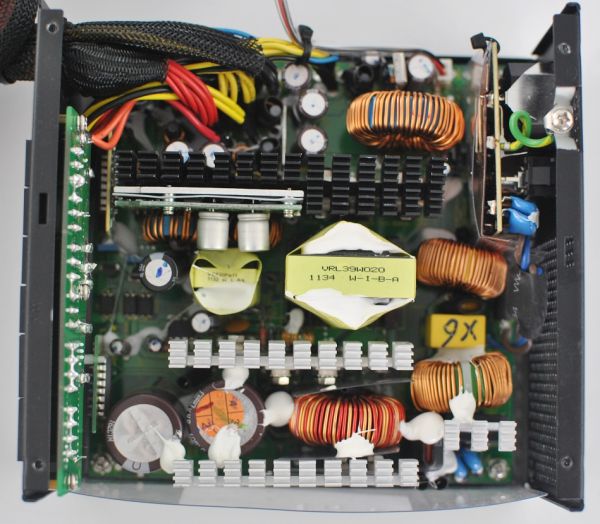NZXT HALE82 650W and 750W
by Martin Kaffei on January 26, 2012 8:20 PM EST- Posted in
- Cases/Cooling/PSUs
- Seasonic
- PSUs
- 80Plus Bronze
- 750W
- NZXT
- 650W
Internal Design and Components
The power supply is based on a circuit design that is identical to the Seasonic M12 II Bronze and the Corsair TX V2 series. NZXT operates with a forward converter with two MOSFETs, which allows the manufacturer to use a higher switching frequency and lower voltage rating for the transistors. In this case the design consists of a primary controller for PFC in continuous current mode and a DC-to-DC converter for +3.3V and +5V as well. This should also clarify how the majority of the output voltages are regulated. The PWM controller of each output takes over this task.
All the heatsinks are relatively small and are punched into an optimized shape. Most of the circuit boards are made out of epoxy resin and fiberglass. In contrast to the 650W model, the 750W unit uses larger filtering capacitors in the primary circuit and generally a bit more powerful semiconductors. The EMI filtering is well equiped with two common-mode chokes, another choke against differential mode EMI, six (!) Y capacitors, two X capacitors, and one MOV.
The only thing keeping this from being a truly high-end classification is the 80 Plus Bronze certification. Seasonic had a few 80 Plus Silver PSUs with a similar structure a while back, which would only require MOSFETs with a lower drain-source resistance. Overall, the design of the HALE82 is definitely more than common 80 Plus Bronze PSUs. We will see a very similar design in the near future with the G-series from Seasonic, which is certified 80 Plus Gold.

















5 Comments
View All Comments
Beenthere - Thursday, January 26, 2012 - link
...then details like cabling, warranty, customer support should be considered IMO.Alecthar - Thursday, January 26, 2012 - link
Agreed, though Corsair always loses out (for me at least) on their 650W TX models because they only allow for 2 PCI-E connectors (without adapters). It feels very much like a transparent move to force you up a tier to the 750W supply, or to a more expensive HX unit. It's all the more irritating given that XFX sells a nearly identical supply (same ODM, Seasonic, on the same platform from Seasonic) with the full 4 PCI-E connectors.As for being price competitive, given that the NZXT supplies are partially modular, they're more comparable to the TX series "M" semi-modular units, which are priced at a premium. The HALE82 is priced identically to the TX650M, and has a superior cable set, due to the inclusion of 2 more PCI-E connectors. I'd say that on the 650W model, NZXT has one of the more compelling "budget friendly" sem-modular options.
nubnubbins - Friday, January 27, 2012 - link
Exactly. While the Corsair TX V2, Hale82, and Seasonic M12II SS are all the same platform, they have different feature sets. The fact that the Hale82 is modular is a huge difference for many builders and many are willing to pay a premium for the easier cable management and cleaner look it provides..The other modular competitors (in terms of quality) at 650w are the Seasonic M12II SS, Enermax Modu82+, Corsair TX-M, and Corsair HX.and the Seasonic M12II SS, Enermax NAXN 82+, and Corsair TX-M at 750w. When you look at the field, the Hale82 comes in cheaper than all of them. To me, that makes it a clear winner.
ssj3gohan - Friday, January 27, 2012 - link
This is like nails on a chalkboard to anyone doing anything with electronics:"Given the higher amperage of the A70GL model, this fan might reach higher speeds, e.g. 3000+ RPM."
It's 'current rating', not 'amperage'.
prophet001 - Friday, January 27, 2012 - link
Not to be a schmuckFrom Dictionary.com
amperage [ˈæmpərɪdʒ]
n
(Physics / General Physics) the magnitude of an electric current measured in amperes, esp the rated current of an electrical component or device